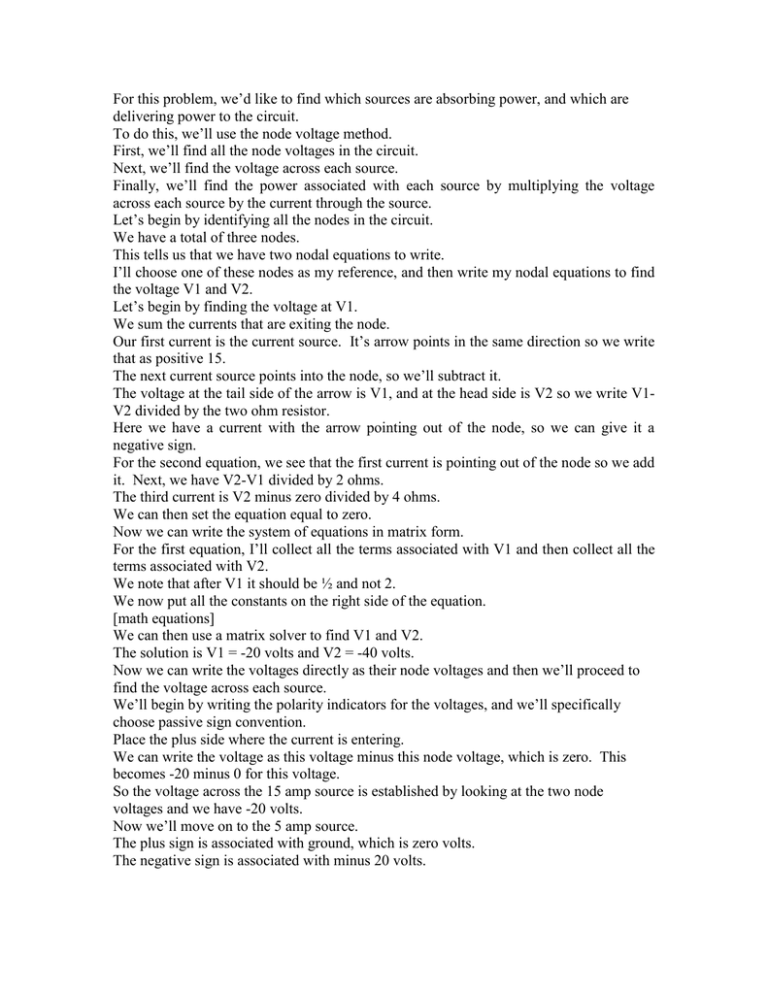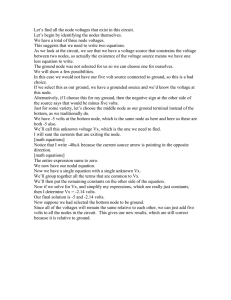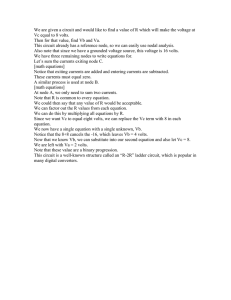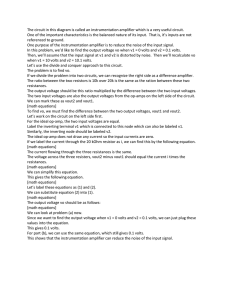For this problem, we’d like to find which sources are... delivering power to the circuit.
advertisement

For this problem, we’d like to find which sources are absorbing power, and which are delivering power to the circuit. To do this, we’ll use the node voltage method. First, we’ll find all the node voltages in the circuit. Next, we’ll find the voltage across each source. Finally, we’ll find the power associated with each source by multiplying the voltage across each source by the current through the source. Let’s begin by identifying all the nodes in the circuit. We have a total of three nodes. This tells us that we have two nodal equations to write. I’ll choose one of these nodes as my reference, and then write my nodal equations to find the voltage V1 and V2. Let’s begin by finding the voltage at V1. We sum the currents that are exiting the node. Our first current is the current source. It’s arrow points in the same direction so we write that as positive 15. The next current source points into the node, so we’ll subtract it. The voltage at the tail side of the arrow is V1, and at the head side is V2 so we write V1V2 divided by the two ohm resistor. Here we have a current with the arrow pointing out of the node, so we can give it a negative sign. For the second equation, we see that the first current is pointing out of the node so we add it. Next, we have V2-V1 divided by 2 ohms. The third current is V2 minus zero divided by 4 ohms. We can then set the equation equal to zero. Now we can write the system of equations in matrix form. For the first equation, I’ll collect all the terms associated with V1 and then collect all the terms associated with V2. We note that after V1 it should be ½ and not 2. We now put all the constants on the right side of the equation. [math equations] We can then use a matrix solver to find V1 and V2. The solution is V1 = -20 volts and V2 = -40 volts. Now we can write the voltages directly as their node voltages and then we’ll proceed to find the voltage across each source. We’ll begin by writing the polarity indicators for the voltages, and we’ll specifically choose passive sign convention. Place the plus side where the current is entering. We can write the voltage as this voltage minus this node voltage, which is zero. This becomes -20 minus 0 for this voltage. So the voltage across the 15 amp source is established by looking at the two node voltages and we have -20 volts. Now we’ll move on to the 5 amp source. The plus sign is associated with ground, which is zero volts. The negative sign is associated with minus 20 volts. So the voltage across the source is zero minus a minus 20 volts, which is the same thing as 20 volts. Now for the third source, we have plus associated with minus 40, negative associated with minus 20 volts so that would be -40 minus -20 which is -20 volts. Now the power is the product of voltage and current. The power associated with the 15 amp source is the voltage across with is -20 times the current through, which is 15. This gives -300 watts. The negative sign tells us that the source is delivering power to the circuit. For the 5 amp source, we have a positive 20 volts times 5 amps or 100 watts. So this source is absorbing power. For the 20 amp source, we have -20 volts times 20 amps, which is -400 watts so this is delivering power to the circuit.









